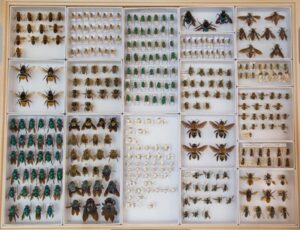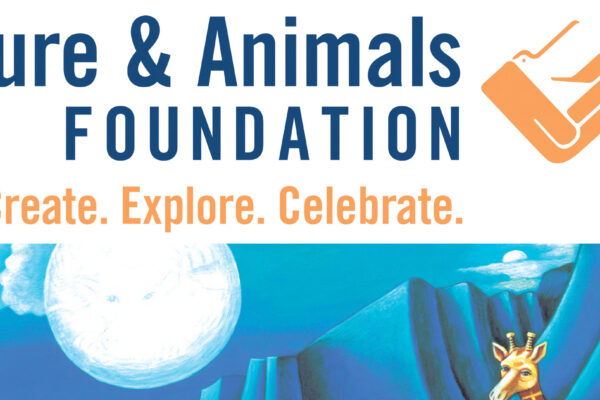Whitney Barlow Robles, the 2023 Tom Regan Research Fellow, reflects on her time in the Regan Archives at North Carolina State University Libraries.
In September 2023, I spent a full month immersed in the off-site storage of the North Carolina State University Libraries as their Tom Regan fellow for 2023. This was my first formal research trip for my second book, as my first, Curious Species: How Animals Made Natural History, doesn’t hit shelves (or e-readers, or ears for the audiobook-inclined) until late November of this year. My barely hatched, fledgling, wobbly-legged second project—can you tell how new it feels?—is tentatively titled The Collector’s Paradox. It unravels the centuries-long history of museum collecting and its contradictory relationship to preservation, as one might expect, but also to destruction.
While the book disembarks in the early modern period and the world of curiosity cabinets, where both humans and other species fell prey to the collecting craze, one major thread of the project that persists into the present is the collecting of animal specimens for scientific research. On one hand, this arm of the project uncovers the pathos of collecting. Scientists are human beings, with emotions just like anyone else. How do biologists feel—and how have they felt over time—when they must kill the creatures they have devoted their lives to studying? Is it necessary to sacrifice individuals to save populations and species? Is there cognitive dissonance, as experienced by those who advocate for “compassionate collection”? Or for others, why do the ends justify the means? So-called type and voucher specimens, after all, are the backbone of modern taxonomy and answer vital questions about biodiversity. Beyond this question of sentiment, I’m also interested in ongoing debates within conservation biology over whether scientific collecting can jeopardize fragile populations in an era of ever-accelerating biodiversity loss. While scientific papers have been published on the topic in this century, it’s a much deeper historical conversation, too.
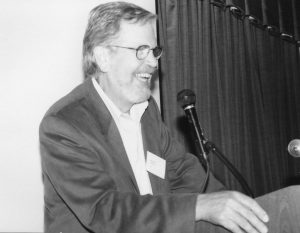 To begin to tackle these questions, I worked with two very different sorts of archives at the Special Collections Research Center of the NC State University Libraries, deliberately putting them in conversation and contrast. First was the Animal Rights Archive spearheaded by Tom Regan (left), the namesake of my fellowship who was a philosophy professor at NC State and prolific scholar on animal rights. This now-massive collection is the largest of its breed in the nation and continues to grow yearly. I worked with a motley crew of its documents: natural history books from the nineteenth and early twentieth centuries, institutional grey literature, pamphlets, philosophy journals, student protest letters, and records related to legal frameworks like the Endangered Species Act and the multilateral treaty CITES (the Convention on International Trade in Endangered Species).
To begin to tackle these questions, I worked with two very different sorts of archives at the Special Collections Research Center of the NC State University Libraries, deliberately putting them in conversation and contrast. First was the Animal Rights Archive spearheaded by Tom Regan (left), the namesake of my fellowship who was a philosophy professor at NC State and prolific scholar on animal rights. This now-massive collection is the largest of its breed in the nation and continues to grow yearly. I worked with a motley crew of its documents: natural history books from the nineteenth and early twentieth centuries, institutional grey literature, pamphlets, philosophy journals, student protest letters, and records related to legal frameworks like the Endangered Species Act and the multilateral treaty CITES (the Convention on International Trade in Endangered Species).
But in addition to examining an archive already preoccupied with animal welfare, I also wanted to immerse myself in the papers of scientists themselves. As luck would have it, many biologists who have worked at NC State over the years have donated their personal and professional papers to the institution. So, NC State was an ideal place to combine these two lines of inquiry.
And yet, where exactly to start unpacking the ethics of collecting was a tricky question for both archives. There are hardly any mentions of scientific collecting in the finding aids for the Animal Rights Archive at all. As a historian who has worked in dozens of archives across three continents, I can attest that NC State’s findings aids are very exhaustive. Yet I still had a hunch I would find material there by casting a wide net and looking through mountains of boxes (as a table in the storage room that started to buckle under their weight before we rescued it can attest). Scientific collecting has never been as attention-grabbing as vivisection, experimentation on laboratory animals, or even the dissection of frogs by schoolchildren. Those forms of scientific research and education have sparked public outcry and organized campaigns in a much more visible manner. Nevertheless, the question of collecting’s ethics would often rear its head as one final paragraph in a document, tacked on as a kind of coda or afterthought. The question has remained subtle and unresolved, but persistent, buzzing in the proverbial ear like a gnat.

Henry Crowe
Take, for example, Henry Crowe’s 1819 Zoophilos, Or, Considerations on the Moral Treatment of Inferior Animals, which is part of NC State’s Bernard Unti Book and Ephemera Collection on Animal Studies within the Animal Rights Archive. Crowe (left) was an English vicar and early writer on animal welfare. At the tail end of a chapter in Zoophilos titled “On CRUELTY in philosophical researches”—which spends most of its airtime exposing the horrors of vivisection—Crowe devotes one final paragraph to the collector’s paradox. His conclusions, however, are mixed. Feeling compelled to discuss “another cruelty,” he describes that “species of curiosity which characterises a virtuoso, and which appears in collecting butterflies, moths, beetles, and other insects. These we see sometimes to the number of several hundreds, all impaled on pins, previously dipped in vitriolic acid, or some other, to kill them; and forming a paltry exhibition at best.” By virtuosos, Crowe here refers to curious dabblers and amateur naturalists assembling private collections of pinned insects. “This pursuit is generally called harmless,” he writes, though he finds it “both trifling and inhuman” and thus concludes: “I see no plea adequate to the sacrificing of so many lives.” However, Crowe does not place a moratorium on all animal collecting. He suggests “something may be said in favour of the practice” in “museums of natural curiosities . . . where the great classes of animals are arranged.” In other words, Crowe could justify collecting animals for systematic natural history and drawing up a taxonomic map of the natural world.[1]
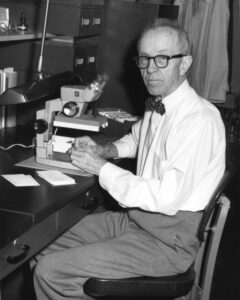
Theodore B. Mitchell
In contrast to plumbing an archive of writers and activists critiquing or contextualizing scientific practice, I also spent my fellowship time reading the papers of biologists who collected animals during their careers. I wanted to see if they pondered the collector’s paradox, and even if not, what motivated them to collect. One of the most fascinating collections on this front were the papers of Theodore B. Mitchell, a specialist in wild bees, especially of the family Megachilidae, the so-called leafcutters. Mitchell (left), who was born in 1890 and died in 1983, taught and researched at NC State during a career that spanned nearly the full arc of the twentieth century.
Mitchell was a juggernaut in systematic entomology. Some in Mitchell’s field regarded his two-volume Bees of the Eastern United States as “our bible.” His letters, even when focused on the drier ins-and-outs of bee taxonomy and identification, delight with moments of levity and personality. And while I can only give an initial glimpse here into what I found in his voluminous archive, I can say that a pattern emerges: Mitchell collected insects like a bee gathers pollen on its legs. It was nearly instinctual, something he’d do not only when on National Science Foundation–sponsored collecting trips but also incidentally—while waiting to be picked up by car, when wandering ditches at the side of the road, by chasing a butterfly well outside his research specialty after it wafted into the lab. His net and “killing bottles,” jars that dispatched live insects through the aid of cyanide fumes, were never far from hand. Mitchell always looked forward to his bouts of “intensive collecting.”[2]
What stands out is the sheer volume of insect specimens Mitchell collected and swapped with his correspondents. And it wasn’t only Mitchell: his papers hold an NSF grant application from the Cornell entomologist Roger Morse, dated 1961, which proposed to collect at minimum 100,000 bee specimens over the following five years and boasted as a credential that Morse had already collected 34,000 wild bees over the previous four. These tallies are somewhat inflated compared to, say, vertebrate groups, simply because of how numerous insects are as lifeforms on this planet. But the numbers are still staggering.[3]
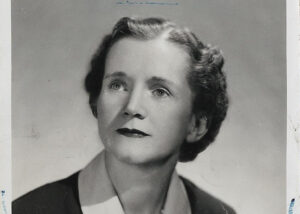
Rachel Carson
Mitchell and his peers seemed to treat pollinators—now poster bugs of concern in the Anthropocene—as an inexhaustible resource, taking specimens of species for which they already had many brethren resting still on pins in drawers. But it can hardly be said that Mitchell was out of tune with conservation or unconcerned with the welfare of insects. On the contrary, he warned of the pesticide DDT’s effect on bees and other “beneficial insects” in a 1946 article, more than fifteen years before Rachel Carson (left) published Silent Spring. In 1949, he begged the dean’s office for teaching release and extra research funding for the summer term, pleading: “time is becoming important, for the rapid rate at which new insecticidal materials are being produced and the increased effectiveness of these materials, creates dangers to our beneficial insect fauna that are too little appreciated. In the case of our native pollinators, we need to know what they are before something happens to depreciate their numbers. If we decimate any of these species before we are even aware of their importance, the solution of pollination problems may become extremely difficult.”[4]
Nevertheless, Mitchell’s archive was fruitful for its lack of reflection on the collector’s paradox. He never outwardly expressed any qualms about killing and collecting his beloved bees. Why, then, did Mitchell collect? What good were specimens, in his mind?
Setting aside any sort of Baudrillardian psychoanalysis, we can look at how Mitchell actually used the specimens he collected—not to mention the legions of others he examined in museums or received from others in the mail. In one letter—from 1949, so comparatively early in his career—Mitchell estimated somewhere around 100,000 bee specimens had already passed through his hands. By decree of the International Code of Zoological Nomenclature, animal taxonomy’s law of the land, typically at least one “type” specimen must be designated to name and describe a new species, upon which it will remain the ultimate reference forever after. This specimen is almost always a dead creature housed in a museum. A “name-bearing” type specimen essentially brings a species into being. (In Mitchell’s words again: “we need to know what they are before something happens to depreciate their numbers.”)
But biologists of the past and now have also valued a large volume of specimens. In many cases, taxonomists will base a formal description of a species on a type series rather than one lone representative. And collecting throughout the habitat range of an animal allows scientists to understand its geographic distribution. Mitchell wrote of one species in 1969: “Not only is there a possibility of variation in local populations, but if sufficient collecting were done we might find that there is a cline, connecting the form in the Southeast with that in Texas, and on to Utah and Oregon.” Moreover, collecting males and females captures the diversity of sexually dimorphic species—as does collecting the in-betweens, like gynandromorphs. Preserving specimens of the entire life cycle of a creature—from larvae and pupae through adult bees, not to mention gathering specimens of nests, hives, and their favorite plants to pollinate—allows a fuller life picture of a bee’s ecology and evolutionary history. Housing duplicates can serve as a backup in the case of disaster and enable loans out to other institutions and researchers who may not be able to travel. In making entomological species determinations, investigators like Mitchell have compared bee coloring, bee wings, bee genitalia, bee “sculpturing”—bee everything.[5]
The potential scientific uses of specimens far exceeds this short list. Mitchell, with his reticence on the ethics of collecting, is just one sample. Other scientists I encountered in the archives did confront the paradox head-on. But Mitchell’s high-throughput approach to collecting is, and has historically been, widespread and more or less dominant in the biological sciences.
Reading the Animal Rights Archive alongside the scientific archive allows the two to interrogate each other. Against the backdrop of the atomic age and 1960s counterculture in the latter half of the twentieth century, some corners of the scientific profession began to place the magnifying lens on themselves. Take Catherine Roberts, a microbiologist, geneticist, and philosopher whose papers form part of the Animal Rights Archive. In a debate on animal experimentation with Robert J. White laid down in print in 1971, she wrote with millenarian zeal: “The new biologists, no longer satisfied with the supreme authority of established science, are striving for a higher ethical vision and a purer conscience than their predecessors had.” That conviction has now been posed of collecting in the twenty-first century. Ecologist and conservation biologist Allison Q. Byrne recently stirred the pot in a 2023 article published in PLOS Biology and titled “Reimagining the Future of Natural History Museums with Compassionate Collection.” Byrne suggests that “live specimen collection is a relic of the extractive, colonial science practices of the 20th century” and advocates instead for non-lethal collecting measures such as photography, video, and DNA analysis alongside allocating resources to care for the millions upon millions of specimens already sitting in museums, waiting to be studied and waiting to inspire.[6]
What remains, then, is the stickiness of the paradox—even when it goes unsaid—and the debate’s persistence into a century of our own.
My deepest gratitude goes to the Culture & Animals Foundation for their support of this research and all the archivists and librarians at NC State who made it happen—especially Gwynn Thayer, Cathy Dorin-Black, Clara Wilson, and Gevorg Vardanyan.
[1] Henry Crowe, Zoophilos, Or, Considerations on the Moral Treatment of Inferior Animals (London, 1819), 72–73.
[2] Theodore B. Mitchell Papers, NC State University Libraries, MC 00183, Box 9 (“our bible”), Half Box 7 (“killing bottles”).
[3] Theodore B. Mitchell Papers, NC State University Libraries, MC 00183, Box 3.
[4] Theodore B. Mitchell, “DDT As a Threat to Bees,” Research and Farming 4, no. 3 (1946): 1, 2, 11; Theodore B. Mitchell Papers, NC State University Libraries, MC 00183, Box 5 (“time is becoming important”).
[5] Theodore B. Mitchell Papers, NC State University Libraries, MC 00183, Box 1 (“Not only”), Box 2 (“sculpturing”).
[6] Catherine Roberts Papers, NC State University Libraries, MC 00323, Box 1 and 2; Catherine Roberts, “Dr. Roberts Replies,” The American Scholar 40, no. 3 (Summer 1971): 509; Allison Q. Byrne, “Reimagining the Future of Natural History Museums with Compassionate Collection,” PLOS Biology 21, no. 5 (2023): e3002101.



